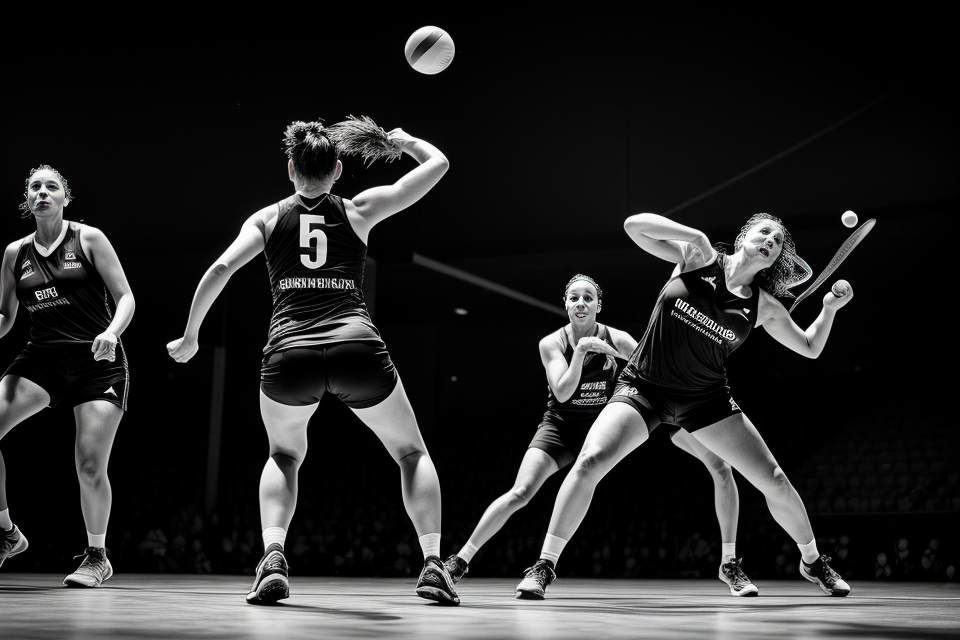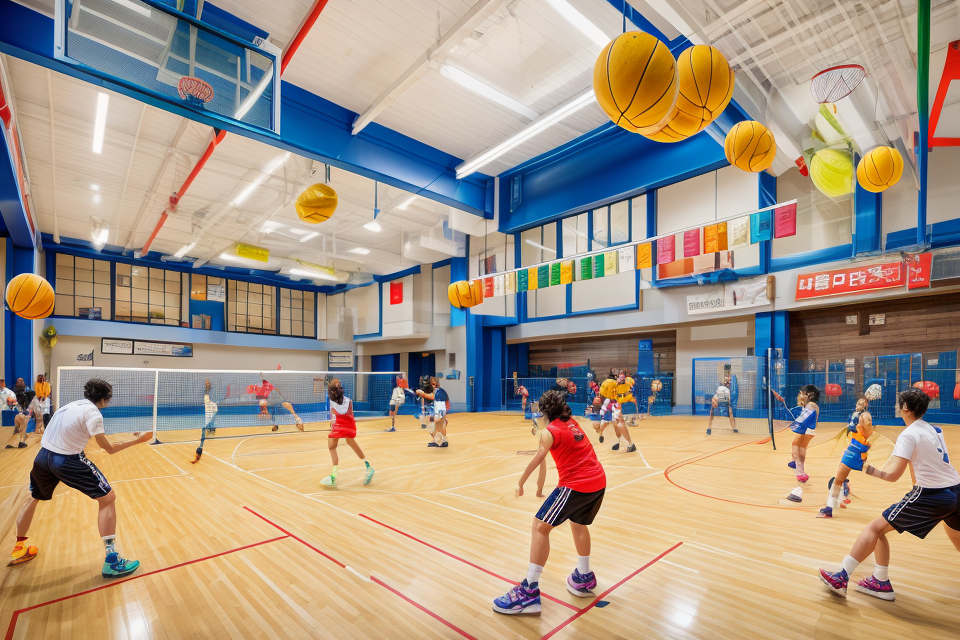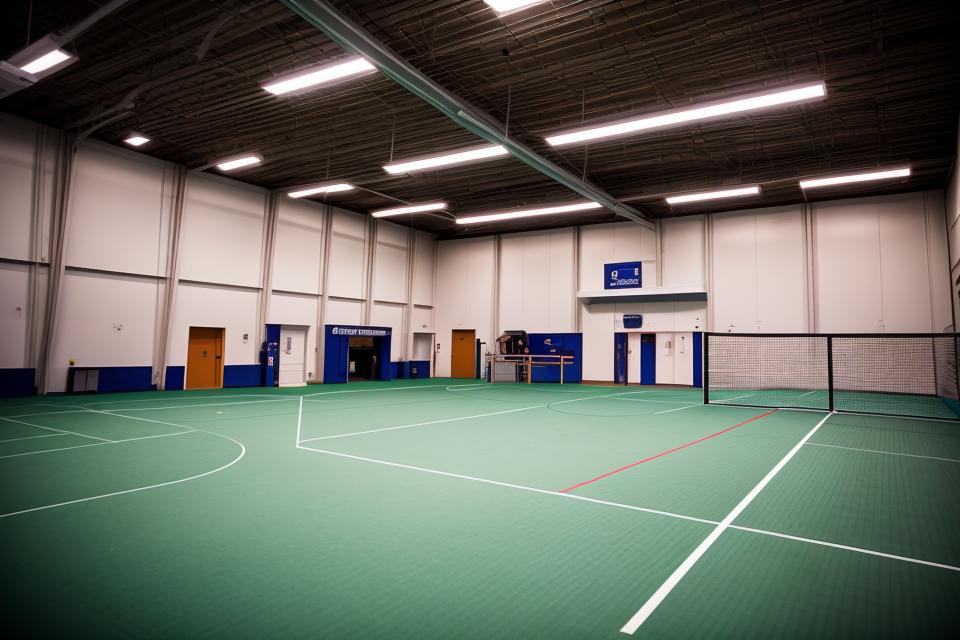Squash is a racket sport that demands both physical and mental prowess. It is played with a small, heavy ball and a racquet, and the aim is to hit the ball against the wall in such a way that your opponent cannot return it. The fast-paced nature of the game, combined with the small court size, makes it one of the most challenging racket sports out there.
One of the main reasons why squash is considered the hardest racket sport is due to the physical demands it places on players. The game requires lightning-fast reflexes, excellent hand-eye coordination, and incredible fitness levels. Players need to be able to move quickly and accurately across the court, and they must also be able to generate power and accuracy with their shots.
In addition to the physical demands of the game, squash also requires a high level of mental fortitude. The fast-paced nature of the game means that players must be able to think and act quickly, and they must also be able to adapt to changing situations on the fly. This requires a great deal of mental focus and discipline, and it is one of the reasons why squash is considered such a challenging sport.
Overall, squash is a demanding sport that requires a combination of physical and mental abilities. Its fast-paced nature, small court size, and physical demands make it one of the most challenging racket sports out there, and it is no surprise that it is considered one of the toughest sports in the world.
Squash is considered the most challenging racket sport due to its fast-paced and high-intensity nature. The small court size and confined space require players to have excellent hand-eye coordination, footwork, and endurance. Additionally, the ball travels at high speeds, making it difficult to return, and the rallies can be long and physically demanding. The combination of these factors, along with the mental and strategic aspects of the game, make squash a highly challenging sport that requires a high level of skill and fitness.
The Physical Demands of Squash
Fitness Requirements
Squash is widely regarded as the most challenging racket sport due to the high level of fitness required to excel at the game. In order to perform at the highest level, players must possess a combination of strength, power, speed, agility, and endurance. These physical attributes are crucial for success in squash, and this section will delve into the specific fitness requirements that make squash such a demanding sport.
Aerobic Capacity
Aerobic capacity refers to the body’s ability to efficiently deliver oxygen to the muscles during physical activity. Squash is an aerobic sport that requires players to move around the court quickly and efficiently, and as such, players must have a high level of aerobic fitness in order to avoid fatigue and maintain peak performance. This means that squash players need to have a well-developed cardiovascular system that can deliver oxygen to the muscles during sustained periods of exercise.
Strength and Power
Squash is a sport that requires players to hit the ball with great force, and as such, players need to have a high level of strength and power in their arms, shoulders, and legs. This is particularly important when it comes to executing shots that require players to hit the ball with maximum velocity and accuracy. Strength and power training can include exercises such as weightlifting, resistance training, and plyometrics, which can help to develop the muscles needed for success in squash.
Speed and Agility
Speed and agility are essential for success in squash, as players need to be able to move quickly and efficiently around the court. This requires excellent footwork, quick reflexes, and the ability to change direction rapidly. Squash players need to be able to move in all directions, and must have the speed and agility to reach balls that are hit to the far corners of the court.
Flexibility and Mobility
Flexibility and mobility are also important in squash, as players need to be able to move their bodies into a variety of positions in order to hit the ball with accuracy and power. Squash players need to have a high level of flexibility in their joints and muscles, particularly in the legs, hips, and lower back. This is important for executing shots that require players to stretch and twist their bodies into unnatural positions. In addition, mobility training can help players to improve their range of motion and prevent injuries.
Skill Development
Squash is a demanding sport that requires a high level of physical fitness, technical skill, tactical knowledge, and mental fortitude. Among these aspects, skill development is a crucial component that sets squash apart from other racket sports. In this section, we will explore the various technical abilities that players need to master in order to excel in squash.
Technical Abilities
- Racket Control: Racket control is the foundation of squash, and it involves the ability to hit the ball with precision and accuracy. Players need to develop the muscle memory to hit the ball with different parts of the racket, such as the tip, the sweet spot, or the heel. This requires hours of practice and repetition to master the technique.
- Footwork: Squash is a fast-paced sport that demands quick movements and agility. Players need to develop the ability to move seamlessly around the court, with rapid changes of direction and sudden stops. This requires a combination of strength, endurance, and coordination.
- Eye-Hand Coordination: Squash is a sport that involves a lot of multitasking, as players need to keep track of the ball, their opponent, and their own movements. Eye-hand coordination is crucial for hitting the ball with accuracy and power. This skill can be developed through drills that focus on tracking the ball and hitting it at the right moment.
- Endurance: Squash is a physically demanding sport that requires a high level of endurance. Players need to be able to move around the court for extended periods of time, with short bursts of intense activity. This requires a combination of cardiovascular fitness, muscular endurance, and mental toughness.
Overall, developing these technical abilities requires a lot of time, effort, and dedication. Players need to practice regularly, with a focus on specific skills that need improvement. They also need to develop a keen awareness of their own strengths and weaknesses, and work on strategies to overcome them. With consistent practice and a willingness to learn, players can develop the technical skills necessary to excel in squash.
The Complexity of the Game
Unpredictable Nature
Rallies and Transitions
Squash is renowned for its fast-paced and unpredictable nature, with rallies often lasting for several hits before the ball is finally out of play. This unpredictability stems from the unique characteristics of the squash ball, which bounces in an erratic manner due to its elastic surface. As a result, players must constantly adapt to the changing trajectory of the ball, making it difficult to predict where it will go next.
Furthermore, the court’s narrow dimensions and the walls’ proximity to the playing area mean that the ball can change direction quickly, often catching players off guard. This unpredictability requires players to have lightning-fast reflexes and exceptional court awareness, as they must anticipate their opponent’s movements and adjust their own game plan accordingly.
Court Positioning
Squash is a game that requires players to move around the court rapidly, with quick footwork and agility being essential skills. The unpredictable nature of the ball means that players must be constantly moving and adjusting their position on the court to maintain control of the rally. This requires a high level of mental and physical fitness, as well as excellent court vision and anticipation skills.
In addition, the narrow dimensions of the court mean that players must be able to move sideways as well as forwards and backwards, making it difficult to gain an advantage over their opponent. This adds an extra layer of complexity to the game, as players must be able to adapt to their opponent’s movements and respond quickly to any changes in the game’s momentum.
Opponent’s Movements
Finally, the unpredictable nature of the game is also influenced by the movements of the opponent. In squash, players must be able to anticipate their opponent’s movements and react accordingly, making it a game of both physical and mental skill. This requires players to have excellent court awareness and the ability to read their opponent’s body language and movements, as well as a deep understanding of the game’s tactics and strategies.
Furthermore, the close proximity of the walls to the playing area means that players can use them to their advantage, bouncing the ball off them to catch their opponent off guard. This adds an extra layer of complexity to the game, as players must be able to anticipate their opponent’s movements and respond quickly to any changes in the game’s momentum. Overall, the unpredictable nature of squash is what makes it such a challenging and exciting game, requiring players to possess a wide range of physical and mental skills.
Mental and Strategic Aspects
Adaptability
One of the primary reasons why squash is considered a challenging racket sport is due to its fast-paced nature, which requires players to be adaptable and think on their feet. This adaptability is crucial in squash because the game is constantly changing, and players must be able to adjust their strategies and tactics accordingly. Whether it’s changing the pace of the game, adjusting to the bounce of the ball, or modifying their footwork, players must be able to adapt quickly to succeed in squash.
Reading Opponents
Another essential aspect of squash that contributes to its complexity is the need for players to read their opponents. In squash, each player has their unique style, strengths, and weaknesses, and it’s crucial to understand and analyze these aspects to be successful. Reading an opponent involves observing their body language, the speed and direction of their shots, and their overall playing style. This information helps players to predict their opponent’s next move and adjust their strategy accordingly.
Decision-Making Under Pressure
Squash is a high-pressure sport that requires players to make split-second decisions under intense physical and mental stress. Whether it’s deciding whether to attack or defend, where to position oneself on the court, or how to respond to an opponent’s shot, players must be able to make quick and effective decisions to succeed. This decision-making process is further complicated by the fast pace of the game, which often requires players to make decisions in a matter of seconds.
In conclusion, the mental and strategic aspects of squash are what make it such a challenging racket sport. From adaptability to reading opponents to decision-making under pressure, squash requires players to possess a unique combination of physical and mental skills to succeed.
Squash Equipment and Techniques
Specialized Gear
Squash Racket
A squash racket is the primary tool used in the sport of squash. It is a small, lightweight racket with a solid or strung frame and a handle. The racket’s string tension and shape play a significant role in the game, and choosing the right racket is crucial for success. A player must consider factors such as the racket’s balance, weight, and string tension when selecting a racket. A well-balanced racket will provide more control, while a heavier racket will generate more power.
Squash Shoes
Squash shoes are designed specifically for the sport and offer better support and traction on the court’s slippery surface. They typically have a non-marking outsole to prevent scuff marks on the court and a sturdy, supportive upper for durability. Squash shoes also feature a breathable and comfortable design to keep the player’s feet dry and comfortable during the game.
Eyewear and Accessories
Eyewear and accessories are essential for squash players, as they protect the player’s eyes from the impact of the ball and sweat. Squash players often wear protective eyewear with polycarbonate lenses, which provide excellent impact resistance and optical clarity. They may also wear wristbands, sweatbands, and headbands to keep their arms and head dry and cool during the game. These accessories not only enhance the player’s performance but also help prevent injuries and protect their equipment.
Fundamental Techniques
Strokes
In squash, strokes refer to the way the player hits the ball with the racket. The most common strokes used in squash are the forehand and backhand strokes. The forehand stroke is hit with the racket in the front hand, while the backhand stroke is hit with the racket in the back hand. Both of these strokes require precision and control to hit the ball accurately and with power.
Footwork
Footwork is another fundamental technique in squash. Players need to be able to move quickly and efficiently around the court to hit the ball and maintain control of the game. This requires excellent agility, balance, and coordination. Good footwork also involves anticipating the opponent’s movements and being in the right position to hit the ball.
Volley and Drop Shots
Volley and drop shots are two other fundamental techniques in squash. A volley is hit when the ball is close to the net, and the player needs to hit it over the net. A drop shot is hit when the ball is low and bounces quickly, making it difficult for the opponent to hit a return. Both of these shots require precision and control to hit the ball accurately and with power.
Overall, mastering these fundamental techniques is essential for becoming a skilled squash player. It requires a lot of practice and dedication to develop the necessary skills and control to hit the ball accurately and with power.
Squash Communities and Resources
Squash Clubs in Japan
Squash has a significant following in Japan, with numerous clubs and facilities throughout the country. Some of the most prominent squash clubs in Japan are located in Tokyo and Osaka, while other major cities also have a number of clubs that cater to both beginners and experienced players.
Tokyo Squash Clubs
Tokyo is home to some of the best squash clubs in Japan, offering state-of-the-art facilities and a strong community of players. One of the most popular clubs in Tokyo is the Racket Club, located in the Roppongi neighborhood. The club features eight glass-backed courts, a fitness center, and a cafe, making it a popular destination for both locals and visitors.
Another popular club in Tokyo is the Tokyo Squash Club, located in the Shinagawa neighborhood. The club has eight courts, a fitness center, and a restaurant, and is known for its friendly atmosphere and strong community of players.
Osaka Squash Clubs
Osaka is another major city in Japan with a strong squash scene, with several clubs located throughout the city. One of the most popular clubs in Osaka is the Osaka Squash Club, located in the Umeda neighborhood. The club has six courts, a fitness center, and a restaurant, and is known for its modern facilities and strong community of players.
Another popular club in Osaka is the Nishinomiya Squash Club, located in the Nishinomiya neighborhood. The club has eight courts, a fitness center, and a restaurant, and is known for its friendly atmosphere and strong focus on developing junior players.
Other Major Cities
In addition to Tokyo and Osaka, other major cities in Japan also have a number of squash clubs and facilities. For example, the Fukuoka Squash Club in Fukuoka is a popular destination for players in the Kyushu region, while the Nagoya Squash Club in Nagoya is a popular destination for players in the Chubu region. These clubs offer a range of facilities and resources for players of all levels, from beginners to experienced players, and are an important part of the squash community in Japan.
Online Resources and Communities
For those looking to improve their squash game or connect with other players, there are numerous online resources and communities available. These platforms offer a wealth of information, including training videos, forums, and discussion boards where players can share tips and strategies.
Squash Training Videos
One of the most valuable resources for squash players is the plethora of training videos available online. These videos provide instruction on various aspects of the game, such as proper technique, drills, and tactics. Many of these videos are created by professional players or coaches, ensuring that the information provided is accurate and effective.
Some popular platforms for finding squash training videos include YouTube, Vimeo, and various squash-specific websites. By searching for keywords such as “squash training” or “squash drills,” players can easily find a wealth of content to help them improve their game.
Squash Forums and Discussion Boards
In addition to training videos, there are also numerous online forums and discussion boards where squash players can connect with others and share information. These platforms provide a space for players to ask questions, share tips and strategies, and discuss various aspects of the game.
Some popular squash forums include Reddit’s r/squash community, Squashsource, and SquashTalk. These platforms offer a variety of discussions on topics such as equipment, technique, and strategy, as well as updates on squash events and tournaments.
By participating in these forums, players can not only improve their knowledge of the game but also build connections with other players from around the world.
Squash Tournaments and Events
Finally, many online resources and communities also provide information on upcoming squash tournaments and events. These platforms offer a way for players to stay up-to-date on the latest happenings in the squash world, including major tournaments, regional events, and local matches.
By staying informed about these events, players can not only stay connected to the squash community but also potentially participate in tournaments themselves.
Overall, the wealth of online resources and communities available to squash players is a testament to the popularity and dedication of the squash community. Whether looking for training videos, forums, or information on upcoming events, there is no shortage of resources available to help players improve their game and connect with others.
FAQs
1. What makes squash the hardest racket sport?
Squash is considered the hardest racket sport due to its fast-paced and physically demanding nature. The small court size and the fact that the ball can travel up to 160 mph make it a challenging sport that requires excellent physical fitness, agility, and strategic thinking. Additionally, the sport’s high intensity and quick changes of direction put a lot of strain on the body, making it a sport that requires a lot of training and dedication.
2. Is squash more difficult than tennis?
Both squash and tennis are challenging sports, but they have different aspects that make them difficult. While tennis is a sport that requires a lot of endurance and can be played for hours, squash is a much more intense and physically demanding sport. The smaller court size and faster pace of the game make it a sport that requires quick reflexes, excellent hand-eye coordination, and a high level of fitness.
3. What are the physical demands of playing squash?
Playing squash is a highly physical activity that requires excellent cardiovascular fitness, strength, and agility. The sport’s fast-paced nature means that players need to be able to move quickly and change direction quickly, making it a sport that requires a lot of leg power and core strength. Additionally, the sport’s high intensity means that players need to be able to maintain a high level of energy throughout the game, making it a sport that requires a lot of endurance.
4. How do you train for squash?
Training for squash involves a combination of cardiovascular exercise, strength training, and drills specific to the sport. Players need to focus on improving their endurance, leg power, and core strength, as well as developing their hand-eye coordination and strategic thinking. Additionally, players should spend time practicing their footwork and reflexes, as these are essential skills for success in the sport.
5. What are the benefits of playing squash?
Playing squash offers a range of benefits, including improved cardiovascular fitness, increased strength and flexibility, and reduced stress levels. The sport also helps to improve hand-eye coordination, reaction times, and mental focus, making it a great way to improve overall cognitive function. Additionally, squash is a social sport that offers opportunities to meet new people and develop friendships.










